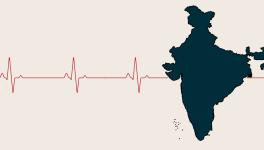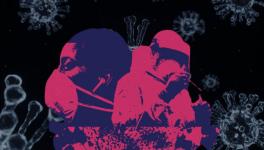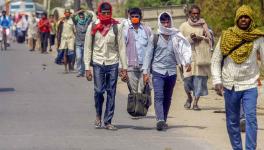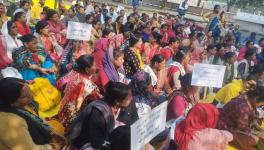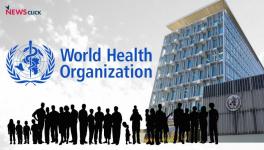Delhi Should Reach Covid-19 Peak Mid-July, Predicts AIIMS Professor Sanjay Rai
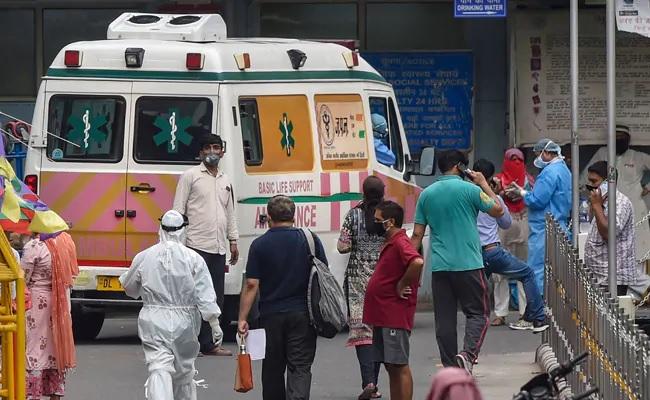
Representational image. | Image Courtesy: NDTV
As President of the Indian Public Health Association, Dr Sanjay K Rai has been studying the spread of the Novel Coronavirus in India and interpreting data to predict the behaviour of the virus, which has claimed over five lakh lives worldwide.
Dr Rai’s knowledge of epidemiology runs deep. His academic credentials are impeccable. He is professor at the Centre for Community Medicine of the prestigious All India Institute of Medical Sciences, Delhi, has published over 100 research papers, and is currently involved in research on human influenza disease burden in India. He also provides technical support to the National AIDS Control Organisation.
In this interview, Dr Rai assesses India’s strategy of lockdown to tackle the Novel Coronavirus, and tracks the trajectory the virus, which has most Indians scared, will likely take in the next few months. Excerpts:
Since both you and I stay in Delhi, let us begin with our city: How far are we from reaching the peak of Covid-19 cases?
It is difficult to say how soon we will reach the peak of Covid-19 cases, the disease caused by the Novel Coronavirus, which is a completely new virus. Based on certain indicators, such as the number of cases and the rate of positivity [the percentage of total tests that turned out positive], Delhi should reach the peak in the middle of July, give or take a week.
As of 29 June, the total number of cases in Delhi stood at 80,196. The word peak suggests a very high number. Are we then going to witness a huge spurt in cases over the next fortnight?
No, we will not witness a huge rise in the number of cases. The epidemiology of Novel Coronavirus shows that in majority of cases, people are either asymptomatic or show very mild symptoms. This feature of the Novel Coronavirus is known to the general public. They, therefore, do not step forward to be tested. In the initial phase of the Novel Coronavirus hitting India, home isolation was not in place. There was fear that anyone who tested positive would be quarantined in an institution for two weeks, completely cut off from his or her family and the world.
If you recall, the ICMR [Indian Council for Medical Research] had conducted sero-surveillance, which is a blood test designed to check for the presence of antibodies in a person. These antibodies are produced in a person for his or her body to combat SARS-CoV-2, which is the name of the Novel Coronavirus.
Obviously, the antibodies produced in a person to combat SARS-CoV-2 will be very different from the antibodies produced to fight other infection.
Yes, definitely. There are thousand types of Coronavirus, but only seven of them infect humans. Even common cold is because of a Coronavirus strain. However, the presence of certain types of antibodies indicates that a person had contracted the Novel Coronavirus at least 14 days before the day he or she went through sero-screening. It takes the body two to six weeks to produce antibodies to counter SARS-CoV-2.
In other words, Delhi’s 80,196 cases only represent the number of people who were symptomatic.
This represents those who came in contact, for a variety of reasons, with the health system and were found positive on testing. In fact, 50% of the 80,196 cases too were likely asymptomatic.
Any estimate of how many people in Delhi could have been infected by SARS-CoV-2?
The best estimate can be reached through sero-surveillance, which is currently underway in Delhi. I, however, feel it will not be less than 10% of Delhi’s population of two crores. So around 20 lakh of people would have had the Novel Coronavirus.
What happens when a given city reaches a peak?
To begin with, peak means a certain percentage of a given population has developed immunity against the Novel Coronavirus. This is the natural way by which the spread of the virus slows.
Let me provide you an imaginary example. Since this is a completely new virus, the entire population is susceptible to it. There is the concept of basic reproduction number, or R0 [pronounced Reproduction Nought], which represents the average number of people infected by one person. Now suppose RO is 3. This means one person is infecting three people; the next three people will infect 9, these 9 will then infect 27, and so on.
As we have discussed, 10% of Delhiites have already been infected and they are therefore protected from re-infection from now on. This means 20 lakh Delhiites cannot be infected for the second time. In other words, effective reproduction number (R) will come down from 3 to 2, which means one person will infect two persons, and they four, and so on. [In other words, the spread of the virus slows]. This how a population acquires what is known as herd immunity, which means a large percentage of people cannot be infected. To break the chain of transmission through herd immunity, we may require 50% to 60% infection rate of SARS-CoV-2 in the community.
So what you are saying is that once Delhi reaches the peak, the number of Coronavirus cases will start declining. How long will Delhi stay at the peak?
This depends on the number of “virgin” people, or those who still remain susceptible to the Novel Coronavirus, that Delhi will add to its population. A city adds new population either through new births or migration. On the basis of evidence we have, those who have been infected already will not develop the disease [called Covid-19].
But this can change tomorrow. Currently, the Novel Coronavirus is self-limiting. The body takes around two weeks to respond to any infection. It produces antibodies, which neutralises the virus. Covid-19 is just four to five months old. Those who have been already infected will have sufficient levels of antibodies to neutralise the virus.
For common cold, the immunity is generally for three months. For SARS-Cov-1, which happened in 2002-03, the immunity was for two years. As for SARS-CoV-2, we do not have any idea [about the duration of immunity] as of now. It is hard to tell what might happen in the future. All that you can say is that the longer the immunity persists, the greater will be the decline in the number of cases.
What about Mumbai, Chennai and India as such? How long will it take each to reach the peak?
In India, each state is like a different country. Delhi will reach the peak by mid-July. You can add approximately one month for Mumbai. For the Northeast states, where the infection level is very low, they are unlikely to reach the peak in the next few months.
What about Bihar, Uttar Pradesh and Jharkhand?
We do not have robust data for these states to categorically claim that the infection level is low. The best way to find out is through sero-surveillance. Yet based on whatever evidence I have seen, I do think the infection level in these state is lower than in Delhi, Chennai and Mumbai.
As on 29 June, Uttar Pradesh had 21,737 cases, Bihar 8,979, and Jharkhand 2,339. Could these low numbers be on account of low level of testing?
Definitely, this is a primary reason behind these low figures. Yet we must also take into account the positivity rate. I have not seen the recent data. But at least 15 days ago, the positivity rate for these three states was very low. Thus, for instance, if out of 100 persons tested, 30 were found positive in Mumbai and Delhi, the figure in these states would have been just five.
How come the positivity rate was is low in these states, given that all of them witnessed a high influx of migrant labourers?
These three states adopted the strategy of mandatory quarantine of two weeks for migrants, who could not therefore go directly to their families. This definitely helped.
How do you look upon Guwahati and Chennai having yet another spell of lockdown?
We now have evidence that measures such as wearing face-masks, washing hands and physical distancing are as effective as lockdown, which has an impact on other aspects of healthcare. People are not dying only because of Covid-19. There are more people dying because of other diseases like cancer.
There is also an economic impact of lockdown to consider.
That impact is long-term. We will know about its consequences in two-three months. But the impact of lockdown on healthcare is immediate. It has been badly affected. Lockdown is not the right strategy. Through it you do not prevent the disease from spreading. You only delay its spread.
We have to learn the art of living with Covid-19. That art involves wearing face-masks, maintaining a certain physical distance from others, constantly washing hands and avoiding overcrowded places. These are measures through which we can effectively slow down the spread of the disease.
How do you look upon India’s lockdown, which was perhaps the most stringent in the world?
In the initial phase [or Phase I of the lockdown, between 25 March and 14 April], the country was not prepared for the Novel Coronavirus. If the objective was to enhance the awareness of people about the virus, it would be acceptable to me. It would also be acceptable to me if the objective was to bolster the health infrastructure.
That said, I have yet to come across a document which spells out, in clear terms, the objectives behind our lockdown. However, if the objective of the lockdown was to eliminate the Novel Coronavirus, I cannot support it. As I have already explained, the spread of the virus can be slowed. It cannot be eliminated. It is, in fact, ridiculous to think the virus can be eliminated.
Did you favour the extension of the lockdown after Phase-I?
No, no, no. Lockdown was and is not the solution to the challenge of Novel Coronavirus, which cannot be eliminated. Every Indian has paid a heavy price for the lockdown and the Coronavirus cases still grew.
Do you think the lockdown was a consequence of the wrong advice given to Prime Minister Narendra Modi?
I do not doubt the sincerity of our prime minister. It is possible that the prime minister was given incorrect advice.
Do we accept we have community transmission? About 18 days ago, on 11 June, the ICMR director Balram Bhargava said in a press conference that India did not have community transmission.
Community transmission, as is well known, means the source of how a person got infected cannot be traced. In majority of cases in Delhi or Mumbai, we have been unable to identify the sources of transmission of the virus.
On 11 June, the ICMR director also released data of sero-surveillance, which had the reference date of 30 April. It said 0.73% of India’s population had been infected. On 30 April, the total number of cases was around 35,500. If you extrapolate from the figure of 0.73%, it would mean around a crore of Indians had been infected by then. But the number of cases then stood at 35,500. That means we were not able to detect the rest.
This is, obviously, an undeniable proof of community transmission. Yet the ICMR refuses to accept it. It also brings us to the absurd conclusion that we will acquire herd immunity without community transmission (laughs). Even an ICMR research paper accepts that the source of 30 to 40% of cases could not be identified.
What could be the purpose behind denying community transmission?
How can I answer that question? You need to ask them.
Do you think the fear regarding the Novel Coronavirus has subsided to a great extent?
I think the fear is very much there, even though the government has tried its best to dispel it. One significant reason is that the Novel Coronavirus is a new virus, and we are not accustomed to it.
How long do you think India will take to return to living normally, as it did, say, until January this year?
Not until early next year.
You say early next year because you think either we will have a vaccine against the virus by then or we will develop herd immunity?
There are various vaccines at an advanced stage of development, as for instance in China, the United States and the United Kingdom. In India, a vaccine will go under trial in the next two weeks. But the world is still said to be six months away from getting a vaccine. Assume a vaccine is very effective. But even then a series of questions arise: in what time-frame can we produce the vaccine for the entire world’s population? What will be its cost? Can we vaccinate each and every person in the world?
You think in six months India will develop herd immunity and, therefore, we can begin to live as we used to?
Yes. The decline in Coronavirus cases in New York did not happen because of some special efforts. The decline was a natural decline, an outcome of herd immunity. You can say the same about the decline in Dharavi, in Mumbai. It will be so in Delhi too.
There has been a shrill debate whether a person who has tested positive should be sent for institutional quarantine or home quarantine. Which do you think is better?
I back home quarantine. As such, our health infrastructure is under heavy pressure. Home quarantine eases pressure on the system. An infected person does not only require medicine, but he or she has to be fed as well. Unless a person with Covid-19 is serious, he or she should remain at home, in isolation. Obviously, not every house in India has space for isolation. In that case, institutional quarantine is the only option.
Get the latest reports & analysis with people's perspective on Protests, movements & deep analytical videos, discussions of the current affairs in your Telegram app. Subscribe to NewsClick's Telegram channel & get Real-Time updates on stories, as they get published on our website.









